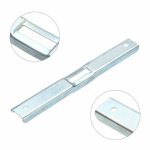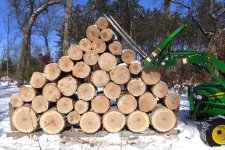What do you use for file guides?
This is probably a much longer answer than you were hoping for, but here goes...
There are two types I tend to use:
The first is a style that clips to the file, holding it at the right height in relation to the tooth. Oregon and Stihl both sell versions of this. (It's important to get the right guide for the size file require for your chain. This is NOT a mix-n-match situation.) I tend to use this the most, for two reasons: it's larger than my second choice, so easier to find when I drop things in the woods, and it's easier to vary one of the angles to suit the style of chain you are using. With this sharpening guide, I use the progressive depth gauge tool shown at the right to set the depth gauge height (I always use the "hardwood" side, since that's 90+% of what I cut. It still cuts softwoods well, and it's easier to handle in hardwood than trying to use the more aggressive softwood setting.)


The other sharpener I use is sometimes referred to as the "Swedish Roller Guide". Advantages: It's compact and easy to carry, it allows for better visibility of the chainsaw tooth as you sharpen, and the two rollers provide an indication of whether you are keeping the file horizontal during the filing stroke (dropping your hand when filing and moving the file out of the proper plane is a common filing error, and really messes up the cutting edge of the tooth and the all-important tip). Downsides: easier to lose if you drop it in the woods (the file is especially easy to lose if it comes out of the handle, or if using a wooden handle that blends in with the forest floor), and every roller guide I've seen is set up to sharpen at a 30˚ angle. That is the ideal angle for most semi-chisel or micro-chisel chains. Full chisel chains generally recommend 25˚. Sharpening a full chisel at 30˚ still works well, but I generally prefer the 25˚ setting. It's possible to do 25˚ on a roller guide, it just takes more attention, since you are running the file at a slight angle to what the rollers and frame are set up to indicate. Most roller guides have a built-in depth gauge tool - see picture on the right below, which works similarly to the one shown above (progressive depth gauge setting).


The Pferd Chain Sharp CSX is a decent tool. It's identical to the Stihl 2-in-1 sharpener (Pferd makes them for Stihl - the pferd unit typically sells for less). I don't own one, but have used one on a number of occasions. It's probably the easiest to learn and quick, since it files the depth gauges at the same time. It does get good results if used properly. The slight downside: since it does not use the "progressive" method of setting the depth gauge to the individual tooth associated with that depth gauge. The non-progressive types set the depth gauge by bridging between two teeth and measuring down from there. This means it is important to keep the cutter lengths all the same (a progressive depth gauge tool is much more tolerant of cutters of different lengths). Also, the lack of the progressive feature means that your cutting performance will suffer slightly as the chain gets filed back. That effect is small, but noticeable. Still it does a good job of sharpening, and it's easy to get results that are better and more consistent than most of us mere mortals can get by freehand sharpening.

A further tip, regardless of what type of guide you use (or if freehand filing): It's possible to do a good job by just setting the saw on a stump or log, or on the tailgate of your truck. It's far easier to do if you have the saw clamped securely in place. I use a stump vise when out in the woods. just tap it into a stump or log, set the powerhead on the stump or log and clamp the bar in the vise. Oregon, Husqvarna and Stihl all make good ones. (Others probably make good ones as well. I can't stand the Timber Tuff brand: they just don't stay in the wood when you tap them in.)


